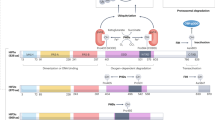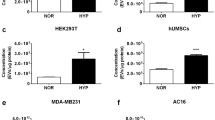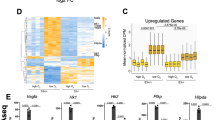Abstract
The role of the hypoxia-inducible factor (HIF) subunits 1α and 2α in response to hypoxia is well established in lung epithelial cells, whereas little is known about HIF-3α with respect to transcriptional and translational regulation by hypoxia. HIF-3α and HIF-1α are two similar but distinct basic helix-loop-helix-PAS proteins, which have been postulated to activate hypoxia responsive genes in response to hypoxia. Here, we used quantitative real time RT-PCR and immunoblotting to determine the activation of HIF-3α vs. HIF-1α by hypoxia. HIF-3α was strongly induced by hypoxia (1% O2) both at the level of protein and mRNA due to an increase in protein stability and transcriptional activation, whereas HIF-1α protein and mRNA levels enhanced transiently and then decreased because of a reduction in its mRNA stability in A549 cells, as measured on mRNA and protein levels. Interestingly, HIF-3α and HIF-1α exhibited strikingly similar responses to a variety of activating or inhibitory pharmacological agents. These results demonstrate that HIF-3α is expressed abundantly in lung epithelial cells, and that the transcriptional induction of HIF-3α plays an important role in the response to hypoxia in vitro. Our findings suggest that HIF-3α, as a member of the HIF system, is complementary rather than redundant to HIF-1α induction in protection against hypoxic damage in alveolar epithelial cells.
Similar content being viewed by others
Log in or create a free account to read this content
Gain free access to this article, as well as selected content from this journal and more on nature.com
or
References
Bergeron M, Yu AY, Solway KE, Semenza GL, Sharp FR . Induction of hypoxia-inducible factor-1 (HIF-1) and its target genes following focal ischaemia in rat brain. Eur J Neurosci 1999; 11:4159–4170
Gross ML, Adamczak M, Amann K, Ritz E . Mediators of inflammatory and ischemic renal damage: the role of neoangiogenesis. J Nephrol 2005; 18:513–520
Kiang JG, Bowman PD, Wu BW, et al. Geldanamycin treatment inhibits hemorrhage-induced increases in KLF6 and iNOS expression in unresuscitated mouse organs: role of inducible HSP70. J Appl Physiol. 2004; 97:564–569.
Zhong H, De Marzo AM, Laughner E, et al. Overexpression of hypoxia-inducible factor 1alpha in common human cancers and their metastases. Cancer Res 1999; 59:5830–5835
Guillemin K, Krasnow MA . The hypoxic response: huffing and HIFing. Cell 1997; 89:9–12.
Semenza GL . HIF-1: mediator of physiological and pathophysiological responses to hypoxia. J Appl Physiol 2000; 88:1474–1480.
Wang GL, Jiang BH, Rue EA, Semenza GL . Hypoxia-inducible factor 1 is a basic-helix-loop-helix-PAS heterodimer regulated by cellular O2 tension. Proc Natl Acad Sci U S A 1995; 92:5510–5514.
Semenza GL . Regulation of mammalian O2 homeostasis by hypoxia-inducible factor 1. Annu Rev Cell Dev Biol 1999; 15:551–578.
Jiang BH, Zheng JZ, Leung SW, Roe R, Semenza GL . Transactivation and inhibitory domains of hypoxia-inducible factor 1alpha. Modulation of transcriptional activity by oxygen tension. J Biol Chem 1997; 272:19253–19260.
Jiang BH, Semenza GL, Bauer C, Marti HH . Hypoxia-inducible factor 1 levels vary exponentially over a physiologically relevant range of O2 tension. Am J Physiol 1996; 271:C1172–C1180.
Salceda S, Caro J . Hypoxia-inducible factor 1alpha (HIF-1alpha) protein is rapidly degraded by the ubiquitin-proteasome system under normoxic conditions. Its stabilization by hypoxia depends on redox-induced changes. J Biol Chem 1997; 272: 22642–22647.
Huang LE, Arany Z, Livingston DM, Bunn HF . Activation of hypoxia-inducible transcription factor depends primarily upon redox-sensitive stabilization of its alpha subunit. J Biol Chem 1996; 271:32253–32259.
Semenza GL, Wang GL . A nuclear factor induced by hypoxia via de novo protein synthesis binds to the human erythropoietin gene enhancer at a site required for transcriptional activation. Mol Cell Biol 1992; 12:5447–5454.
Liu Y, Cox SR, Morita T, Kourembanas S . Hypoxia regulates vascular endothelial growth factor gene expression in endothelial cells. Identification of a 5′ enhancer. Circ Res 1995; 77: 638–643.
Melillo G, Musso T, Sica A, et al. A hypoxia-responsive element mediates a novel pathway of activation of the inducible nitric oxide synthase promoter. J Exp Med 1995; 182:1683–1693.
Lee PJ, Jiang BH, Chin BY, et al. Hypoxia-inducible factor-1 mediates transcriptional activation of the heme oxygenase-1 gene in response to hypoxia. J Biol Chem 1997; 272:5375–5381.
Bruick RK . Oxygen sensing in the hypoxic response pathway: regulation of the hypoxia-inducible transcription factor. Genes Dev 2003; 17:2614–2623.
Tian H, McKnight SL, Russell DW . Endothelial PAS domain protein 1 (EPAS1), a transcription factor selectively expressed in endothelial cells. Genes Dev 1997; 11:72–82.
Gu YZ, Moran SM, Hogenesch JB, Wartman, Bradfield CA . Molecular characterization and chromosomal localization of a third alpha-class hypoxia inducible factor subunit, HIF3alpha. Gene Expr 1998; 7:205–213.
Sato M, Tanaka T, Maeno T, et al. Inducible expression of endothelial PAS domain protein-1 by hypoxia in human lung adenocarcinoma A549 cells. Role of Src family kinases-dependent pathway. Am J Respir Cell Mol Biol 2002; 26:127–134.
Uchida T, Rossignol F, Matthay MA, et al. Prolonged hypoxia differentially regulates hypoxia-inducible factor (HIF)-1alpha and HIF-2alpha expression in lung epithelial cells: implication of natural antisense HIF-1alpha. J Biol Chem 2004; 279:14871–14878.
Wiesener MS, Jurgensen JS, Rosenberger C, et al. Widespread hypoxia-inducible expression of HIF-2alpha in distinct cell populations of different organs. FASEB J 2003; 17:271–273.
Wiesener MS, Turley H, Allen WE, et al. Induction of endothelial PAS domain protein-1 by hypoxia:characterization and comparison with hypoxia-inducible factor-1alpha. Blood 1998; 92:2260–2268.
Heidbreder M, Frohlich F, Johren O, et al. Hypoxia rapidly activates HIF-3alpha mRNA expression. FASEB J 2003; 17:1541–1543.
Yoshida T, Kuwahara M, Maita K, Harada T . Immunohistochemical study on hypoxia in spontaneous polycystic liver and kidney disease in rats. Exp Toxicol Pathol 2001; 53:123–128.
Koyama S, Sato E, Tsukadaira A, et al. Vascular endothelial growth factor mRNA and protein expression in airway epithelial cell lines in vitro. Eur Respir J 2002; 20:1449–1456.
Ouiddir A, Planes C, Fernandes I, VanHesse A, Clerici C . Hypoxia upregulates activity and expression of the glucose transporter GLUT1 in alveolar epithelial cells. Am J Respir Cell Mol Biol 1999; 21:710–718.
Pallet N, Thervet E, Le Corre D, et al. Rapamycin inhibits human renal epithelial cell proliferation: effect on cyclin D3 mRNA expression and stability. Kidney Int 2005; 67:2422–2433.
Yague E, Armesilla AL, Harrison G, et al. P-glycoprotein (MDR1) expression in leukemic cells is regulated at two distinct steps, mRNA stabilization and translational initiation. J Biol Chem 2003; 278:10344–10352.
Pham I, Uchida T, Planes C, et al. Hypoxia upregulates VEGF expression in alveolar epithelial cells in vitro and in vivo. Am J Physiol Lung Cell Mol Physiol. 2002; 283:L1133–1142.
Hara S, Hamada J, Kobayashi C, Kondo Y, Imura N . Expression and characterization of hypoxia-inducible factor (HIF)-3alpha in human kidney: suppression of HIF-mediated gene expression by HIF-3alpha. Biochem Biophys Res Commun 2001; 287:808–813.
Kietzmann T, Cornesse Y, Brechtel K, Modaressi S, Jungermann K . Perivenous expression of the mRNA of the three hypoxia-inducible factor alpha-subunits, HIF1alpha, HIF2alpha and HIF3alpha, in rat liver. Biochem J 2001; 354:531–537.
Maynard MA, Qi H, Chung J, et al. Multiple splice variants of the human HIF-3 alpha locus are targets of the von Hippel-Lindau E3 ubiquitin ligase complex. J Biol Chem 2003; 278:11032–11040.
Hirsila M, Koivunen P, Gunzler V, Kivirikko KI, Myllyharju J . Characterization of the human prolyl 4-hydroxylases that modify the hypoxia-inducible factor. J Biol Chem 2003; 278:30772–30780
Graven KK, Bellur D, Klahn BD, Lowrey SL, Amberger E . HIF-2alpha regulates glyceraldehyde-3-phosphate dehydrogenase expression in endothelial cells. Biochim Biophys Acta 2003; 15:10–18.
Wenger RH, Kvietikova I, Rolfs A, Gassmann M, Marti HH . Hypoxia-inducible factor-1 alpha is regulated at the post-mRNA level. Kidney Int 1997; 51:560–563.
Katschinski DM, Le L, Schindler SG, et al. Interaction of the PAS B domain with HSP90 accelerates hypoxia-inducible factor-1alpha stabilization. Cell Physiol Biochem 2004; 14:351–360.
Masson N, Ratcliffe PJ . HIF prolyl and asparaginyl hydroxylases in the biological response to intracellular O2 levels. J Cell Sci 2003; 116:3041–3049.
Rose F, Grimminger F, Appel J, et al. Hypoxic pulmonary artery fibroblasts trigger proliferation of vascular smooth muscle cells: role of hypoxia-inducible transcription factors. FASEB J 2002; 16:1660–1661.
Li QF, Dai AG . Hypoxia inducible factor-1 alpha correlates the expression of heme oxygenase 1 gene in pulmonary arteries of rat with hypoxia-induced pulmonary hypertension. Acta Biochim Biophys Sin 2004; 36:133–140.
Makino Y, Cao R, Svensson K, et al. Inhibitory PAS domain protein is a negative regulator of hypoxia-inducible gene expression. Nature 2001; 29:550–554.
Ohh M, Park CW, Ivan M, et al. Ubiquitination of hypoxia-inducible factor requires direct binding to the beta-domain of the von Hippel-Lindau protein. Nat Cell Biol 2000; 2:423–427.
Agani FH, Pichiule P, Chavez JC, LaManna JC . The role of mitochondria in the regulation of hypoxia-inducible factor 1 expression during hypoxia. J Biol Chem 2000; 275:35863–35867.
Acknowledgements
The authors are extremely grateful to Prof Jing-yuan Fang of Shanghai Institute of Digestive Disease for excellent technical assistance.
Author information
Authors and Affiliations
Corresponding author
Rights and permissions
About this article
Cite this article
Li, Q., Wang, X., Yang, Y. et al. Hypoxia upregulates hypoxia inducible factor (HIF)-3α expression in lung epithelial cells: characterization and comparison with HIF-1α. Cell Res 16, 548–558 (2006). https://doi.org/10.1038/sj.cr.7310072
Received:
Revised:
Accepted:
Published:
Issue date:
DOI: https://doi.org/10.1038/sj.cr.7310072
Keywords
This article is cited by
-
Multienzymes activity of metals and metal oxide nanomaterials: applications from biotechnology to medicine and environmental engineering
Journal of Nanobiotechnology (2021)
-
Systems-epigenomics inference of transcription factor activity implicates aryl-hydrocarbon-receptor inactivation as a key event in lung cancer development
Genome Biology (2017)
-
miR-429 regulates the transition between Hypoxia-Inducible Factor (HIF)1A and HIF3A expression in human endothelial cells
Scientific Reports (2016)
-
Molecular characterization and expression analysis of three hypoxia-inducible factor alpha subunits, HIF-1α, -2α and -3α in hypoxia-tolerant Indian catfish, Clarias batrachus [Linnaeus, 1758]
Molecular Biology Reports (2013)
-
Hypoxia-Inducible Factor Prolyl Hydroxylase Inhibition: Robust New Target or Another Big Bust for Stroke Therapeutics?
Journal of Cerebral Blood Flow & Metabolism (2012)



